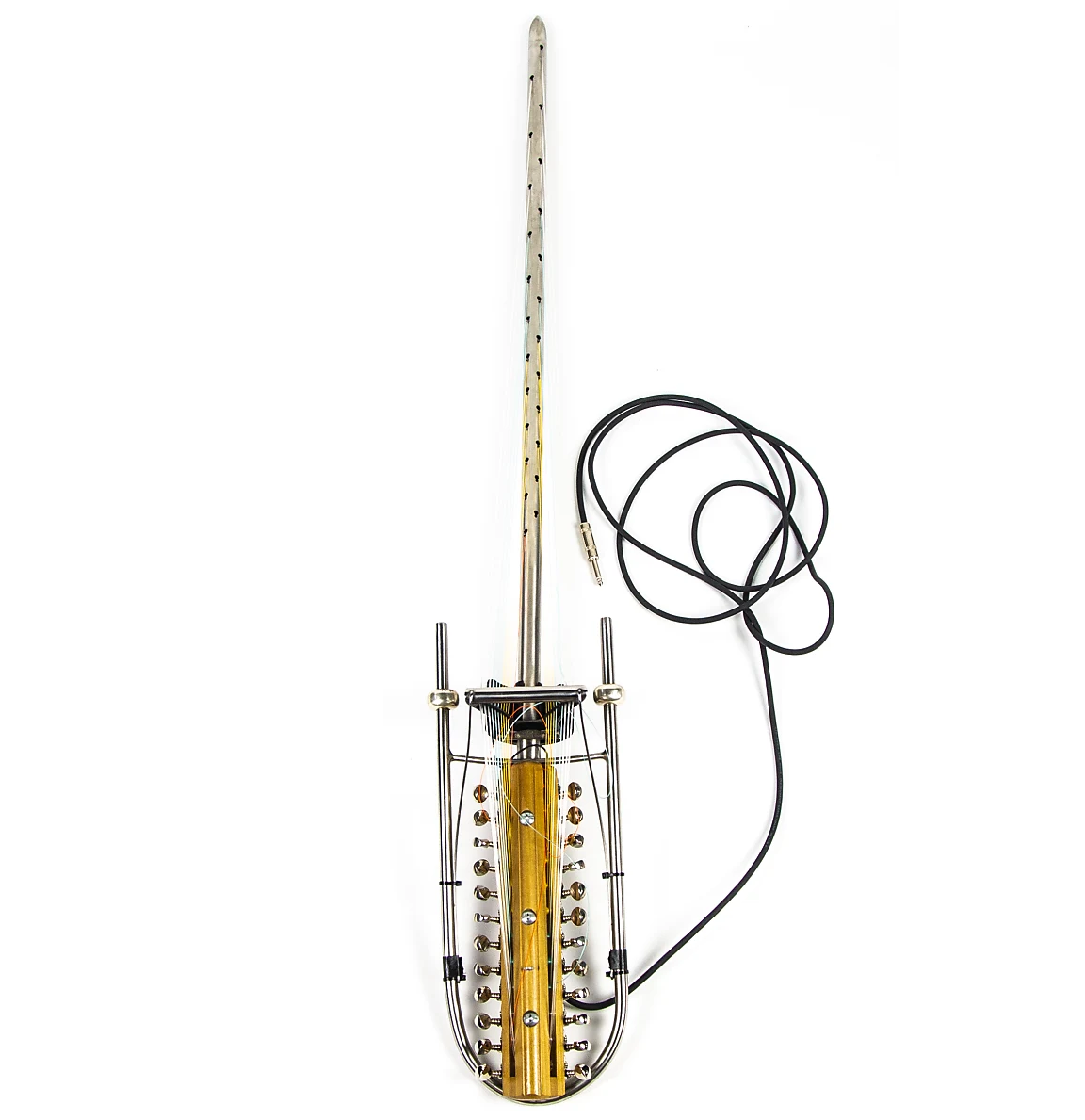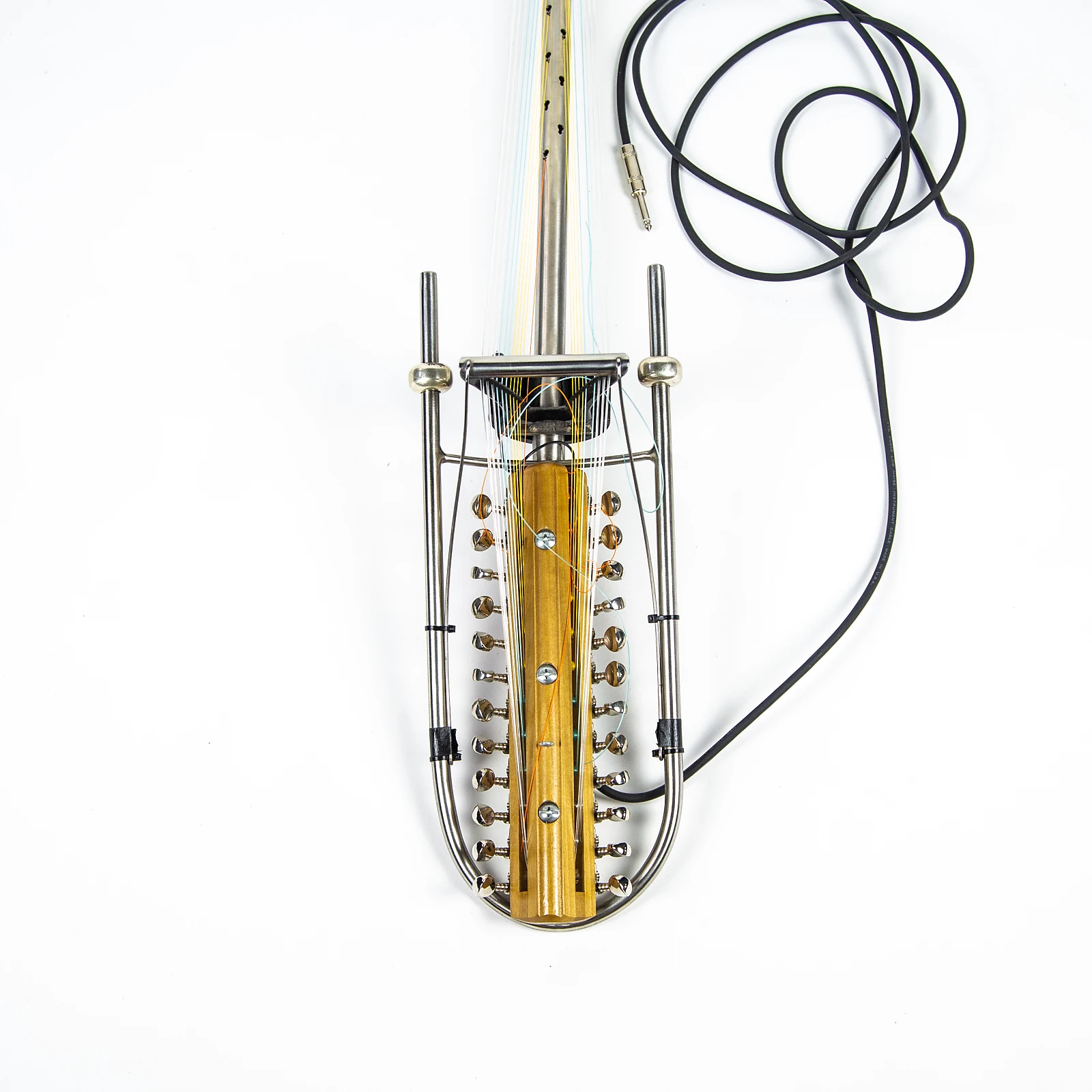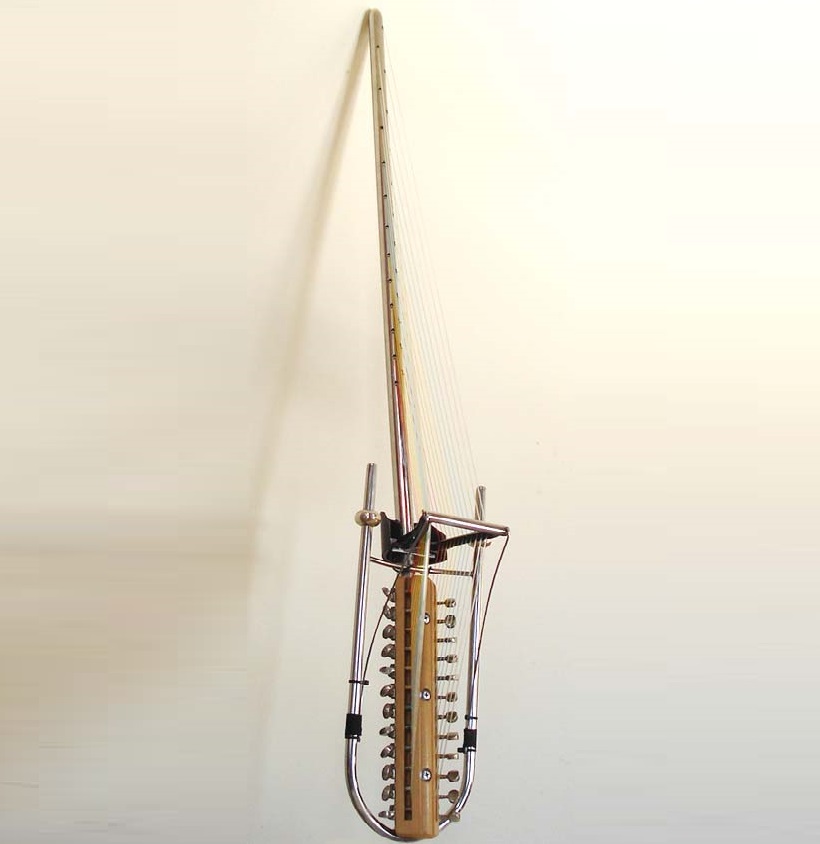Gravikord
Plucked Instruments
America
Between 1901 and present
Video
The gravikord is a contemporary, electrically amplified 24-string harp from West Africa, specifically designed and constructed in the late 20th century. It stands as a testament to the ongoing evolution of musical instruments, drawing inspiration from traditional African harps while incorporating modern design and technology. Its unique sound and visual aesthetic have garnered attention from musicians and enthusiasts worldwide, placing it within the realm of innovative musical creations.
Description
The gravikord is a visually striking instrument, characterized by its elegant, curved neck and the symmetrical arrangement of its strings. It essentially functions as an electric double harp, with two sets of 12 strings, one on each side of the neck. These strings are typically made of nylon or fluorocarbon, and they are plucked or strummed to produce sound. The instrument is designed to be played while held upright, resting on the lap or on a stand. Its body, often crafted from hardwood, serves as a resonating chamber, enhancing the instrument’s tonal qualities. The gravikord’s most distinctive feature is its built-in electric pickup system, which allows for amplification and the application of various electronic effects, expanding its sonic possibilities. This amplification capability distinguishes it from traditional acoustic harps, enabling it to be used in a wider range of musical settings and genres.
Type of Instrument
The gravikord is classified as a chordophone, specifically a plucked string instrument. It falls within the broader category of harps, although it possesses unique characteristics that set it apart from traditional harps found in various cultures. Its design incorporates elements of both the kora, a West African bridge-harp, and the Western concert harp, resulting in a hybrid instrument that bridges traditional and modern musical practices. The gravikord is also considered an electrophone due to its built-in electric pickup system, which allows for electronic amplification. This dual classification highlights its position as a transitional instrument, blending acoustic and electronic sound production.
While the gravikord is primarily known as a single, distinct instrument, there have been some variations and adaptations developed over time. These variations typically involve modifications to the instrument’s design, materials, or tuning system, aimed at achieving specific sonic or playing characteristics. One common variation involves the use of different types of strings, such as steel or gut strings, which can produce different tonal qualities. Some gravikord players also experiment with different tuning systems, adapting the instrument to specific musical styles or genres. Another variation involves the use of different types of wood for the body and neck, which can affect the instrument’s resonance and tone. Additionally, some luthiers and instrument designers have created custom gravikords with unique features, such as built-in effects processors or alternative pickup systems. These custom variations are often tailored to the specific needs and preferences of individual musicians, reflecting the instrument’s versatility and adaptability. While these variations exist, the fundamental design and characteristics of the gravikord remain consistent, ensuring its recognition as a distinct and unique musical instrument.
History and Origin
The gravikord’s history is relatively recent, originating in the late 20th century in the United States, but drawing heavily from the musical traditions of West Africa. It was invented by Robert Grawi, an American musician and instrument designer, who was deeply inspired by the kora, a traditional West African harp-lute. Grawi sought to create an instrument that retained the essential qualities of the kora while addressing some of its limitations, such as its complex construction and limited range. He envisioned an instrument that would be more accessible to a wider range of musicians and capable of being integrated into contemporary musical contexts.
Grawi’s work was rooted in his fascination with African music and culture, which he explored through extensive research and collaboration with West African musicians. He spent considerable time studying the kora and its playing techniques, seeking to understand the instrument’s unique tonal characteristics and expressive potential. His goal was not to replicate the kora but to create a new instrument that would capture its spirit while offering enhanced playability and versatility. The gravikord’s development was a gradual process, involving numerous prototypes and refinements. Grawi experimented with different materials, designs, and tuning systems, seeking to achieve the desired sound and playability. The instrument’s electric pickup system was a key innovation, allowing for amplification and the application of electronic effects, which expanded its sonic possibilities and made it suitable for a wider range of musical genres.
The gravikord’s creation can be seen as a continuation of the long tradition of musical instrument innovation in Africa, where musicians and instrument makers have continually adapted and evolved their instruments to meet the changing needs of their communities. While the gravikord was designed and constructed in the United States, its inspiration and musical heritage are firmly rooted in West African traditions.
Construction and Design
The gravikord’s construction and design are the result of a meticulous process, combining traditional craftsmanship with modern engineering principles. The instrument’s body is typically crafted from hardwood, such as maple or mahogany, which provides a sturdy and resonant foundation. The neck, which is often curved, is designed to accommodate the two sets of strings, each with 12 strings. The strings are attached to tuning pegs at the top of the neck and to a bridge at the bottom, which transmits their vibrations to the body. The gravikord’s most distinctive feature is its symmetrical design, with the two sets of strings arranged on either side of the neck. This arrangement allows for a wide range of playing techniques, including plucking, strumming, and fingerpicking. The strings are typically made of nylon or fluorocarbon, which offer a warm and resonant tone. The instrument’s electric pickup system is integrated into the bridge, capturing the vibrations of the strings and converting them into an electrical signal. This signal can then be amplified and processed through various electronic effects, expanding the instrument’s sonic possibilities.
The gravikord’s design also incorporates ergonomic considerations, making it comfortable to play for extended periods. The instrument’s weight and balance are carefully distributed, allowing it to be held securely on the lap or on a stand. The neck is designed to provide easy access to all of the strings, facilitating complex fingerings and playing techniques. The tuning system is also designed for ease of use, allowing for quick and accurate tuning adjustments.
Characteristics
The gravikord possesses a unique set of characteristics that distinguish it from other musical instruments. Its sound is often described as warm, resonant, and ethereal, with a rich harmonic complexity. The instrument’s electric pickup system allows for a wide range of sonic possibilities, from clean and acoustic tones to heavily processed and electronic sounds. The gravikord’s symmetrical design and string arrangement facilitate a variety of playing techniques, including plucking, strumming, and fingerpicking. Its ergonomic design makes it comfortable to play for extended periods, and its tuning system is designed for ease of use.
The gravikord’s versatility is one of its most notable characteristics, allowing it to be used in a wide range of musical genres. Its sound blends seamlessly with both acoustic and electronic instruments, making it suitable for solo performances, ensemble playing, and studio recordings. The instrument’s unique visual aesthetic also contributes to its appeal, making it a visually captivating instrument to watch and listen to. The gravikord’s ability to bridge traditional and modern musical practices is another important characteristic. Its design draws inspiration from traditional African harps, while its electric pickup system and amplification capabilities make it a contemporary instrument. This blend of tradition and innovation has allowed the gravikord to find a place in a variety of musical contexts, from world music and jazz to experimental and electronic music.
The gravikord’s relatively recent invention has also contributed to its unique characteristics. As a contemporary instrument, it is still evolving and being explored by musicians and instrument designers. This ongoing process of innovation and experimentation is likely to lead to further developments and variations, ensuring the gravikord’s continued evolution and relevance in the world of music. The instrument’s sound often inspires a meditative and contemplative listening experience. The complex harmonic overtones produced by the strings, when amplified, create a rich soundscape that can be both soothing and stimulating. The instrument’s unique tuning and string arrangement allows for the creation of intricate melodies and harmonies, making it a favorite among composers and improvisers. The gravikord’s ability to create a wide range of sonic textures and moods makes it a versatile tool for musical expression. Its sound can be both delicate and powerful, capable of conveying a wide range of emotions and ideas. The gravikord’s unique combination of traditional and modern elements makes it a fascinating and intriguing instrument. It represents a bridge between cultures and musical styles, and its ongoing evolution reflects the dynamic and ever-changing nature of music itself.
Playing Techniques and Sound Modifications
Playing the Gravikord involves a combination of techniques derived from the kora and other stringed instruments. Players typically use their thumbs and index fingers to pluck the strings, creating intricate melodic and rhythmic patterns. The instrument’s design, with strings arranged in alternating scales, facilitates the creation of complex cross-rhythms. One of the Gravikord’s unique features is its ability to produce a wide range of timbres and textures. The piezo-electric pickup allows for amplification and electronic processing, enabling players to modify the sound with effects such as reverb, delay, and distortion. Additionally, the Gravikord’s bridge design includes a feature that allows for variable pitch manipulation, expanding the instrument’s expressive capabilities. The way the strings are layed out, allow for very complex interwoven melodies to be played. The ability to use effects pedals, and amplifiers, gives the player a very wide palette of tonal colors to work with.
Applications in Music
The Gravikord has found applications in various musical genres, including world music, jazz, experimental music, and contemporary classical music. Its unique sound and versatility have attracted musicians seeking to explore new sonic territories. The instrument’s ability to produce both delicate melodies and complex rhythms makes it suitable for solo performances and ensemble settings. Musicians have used the Gravikord to create ambient soundscapes, intricate rhythmic patterns, and expressive melodic lines. The instrument is often used in situations where a unique and interesting sonic texture is desired. It can be used as a solo instument, or blended into larger ensembles.
Most Influential Players
Robert Grawi, the inventor of the Gravikord, is undoubtedly the most influential player. His innovative playing techniques and compositional approaches have shaped the instrument’s development. Other notable Gravikord players have contributed to its growing repertoire and expanding its musical possibilities. These musicians have explored the instrument’s unique capabilities, pushing its boundaries and inspiring new generations of players. These players have helped to create a body of work that shows the wide range of musical styles that the gravikord can be used within. Because the instrument is relatively new, the amount of influential players is still growing. As more players become familiar with its capabilities, the number of influential players will increase.
Maintenance and Care
Maintaining the Gravikord involves regular cleaning, tuning, and string replacement. The stainless steel frame is relatively durable, but the strings and bridge require careful attention. Players should use a soft cloth to clean the instrument and avoid exposing it to extreme temperatures or humidity. Tuning the Gravikord requires a precise understanding of its scale and string arrangement. String replacement should be performed by a qualified technician to ensure proper tension and intonation. Due to the electronic pick-up system, care should also be taken to keep the electronic components clean, and dry. Also, the instrument should be stored in a padded case when not in use, to protect it from damage.
Cultural Significance
The Gravikord holds cultural significance as a modern interpretation of the West African kora. It represents a fusion of traditional African musical concepts with contemporary instrument design and technology. The instrument’s creation reflects a desire to explore new musical possibilities while honoring the rich heritage of African music. The Gravikord has also become a symbol of innovation and creativity in the world of musical instruments. It is a testament to the ongoing evolution of musical expression and the cross-cultural exchange of musical ideas. The Gravikord has been displayed in museums, showing its importance in modern musical instrument design.
The instrument has also been featured in academic settings, and has been the subject of scholarly articles. This helps to solidify its place in the history of musical instruments.
FAQ
Who are some notable players of the Gravikord?
Notable Gravikord players include Robert Grawi, its inventor, and musicians exploring experimental and world fusion music. The instrument is used in contemporary, African, and minimalist compositions. Its unique sound has made it popular in innovative performances. Though niche, it has gained recognition among modern harpists.
What materials are used in the construction of the Gravikord?
The Gravikord is constructed using stainless steel tubing for its frame and synthetic polymer strings for durability. It replaces traditional wooden elements with modern materials, enhancing portability and resilience. The metal frame provides structural integrity, while the strings ensure bright and percussive tonal quality.
What are the key sound characteristics of the Gravikord?
The Gravikord produces a bright, metallic, and percussive sound reminiscent of African harps and kalimbas. Its dual-tone structure allows for polyrhythmic playing, making it suitable for rhythmic and harmonic complexity. The instrument’s design facilitates a smooth yet vibrant timbre, blending plucked and percussive qualities.
 Links
Links
References
Other Instrument
Categories




















